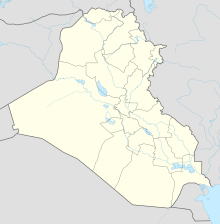Shanidar
Coordinates: 36 ° 48 ′ 9.7 ″ N , 44 ° 13 ′ 51.5 ″ E
Shanidar or Schanidar is a cave in the north of Iraq in the province of Erbil of the autonomous region of Kurdistan . It is located 745 m above sea level on the Großer Zab in the foothills of the Zagros Mountains . The cave is inhabited by nomadic Kurdish tribes in winter . The cave gained international fame when the remains of Neanderthals were found there.
Finds
Excavations were carried out in the cave between 1953 and 1960 under the direction of the American prehistorian Ralph Solecki ( Columbia University , New York). The sequence of strata goes back from modern times to the Middle Paleolithic .
| layer | Culture | Dating |
|---|---|---|
| B1 | Early Neolithic | |
| B1 | Epipalaeolithic | 10,600 ± 300 |
| C. | Baradostia | 33,000-27,000 |
| D. | Moustérien |
A total of nine Neanderthals were excavated in Layer D (Shanidar I to IX). Their age is given as 45,000 to 50,000 years. The remains of three young male Neanderthals were particularly well preserved. It is the only place where Neanderthals have been found east of the Jordan so far .
| No | square | depth | year | description | attitude | conservation | Dating |
|---|---|---|---|---|---|---|---|
| 1 | B7 | 4.34 | 1957 | adult man | Straightener | almost complete skull | approx. 45,000 - 50,000 |
| 2 | D8 | 7.25 | 1957-1960 | adult man | ? | - | 60,000? |
| 3 | A9 | 5.40 | 1957 | adult man | - | almost complete skeleton | approx. 45,000-50,000 |
| 4th | B7 | 7.49 | 1960 | adult man | right stool | - | older than 45,000 |
| 5 | B8 | 4.48 | 1960 | grown up | ? | - | older than 45,000 |
| 6th | B7 | 7.68 | 1960 | adult woman | ? | - | 60,000? |
Table according to Steward 1977, Table 1
Erik Trinkaus assumes that the skulls of individuals I and V were artificially deformed and that the wearer of skull I survived despite hearing impairments and other physical limitations thanks to his group. Layer B1 has been dated to 10600 ± 300 BP (W-667). The protoneolithic settlement of Zawi Chemi is located on the lower terrace of the Großer Zab, in front of the entrance to the village of the same name, Shanidar .
Re-excavation
Since April 2014 Shanidar has been part of the project “How resilient were Neanderthals and Modern Humans in SW Asia to climate change? Reinvestigating Shanidar Cave ”under Graeme Barker ( Cambridge University , Mc Donald's Institute of Archeology) and Tim Reynolds. The project combines the re-excavation of the Shanidar Cave with an investigation into the Paleolithic settlement of the region. During the recent excavations, the remains of three other Neanderthals have been discovered so far. The age of the youngest find is given as 37,000 years.
literature
- Anagnostis P. Agelarakis: The Shanidar cave Proto-Neolithic human population: Aspects of demography and paleopathology. In: Human Evolution. Volume 8, No. 4, pp. 235-253 doi: 10.1007 / BF02438114
- Arlette Leroi-Gourhan : The Flowers found with Shanidar IV, a Neanderthal Burial in Iraq . In: Science , New Series 190 (No. 4214), 1975, pp. 562-564.
- Dexter Perkins Jr .: Prehistoric Fauna From Shanidar, Iraq. In: Science. New Series 144 (No. 3626), 1964, 1565-1566.
- Ralph S. Solecki: Shanidar cave: a paleolithic site in northern Iraq. In: Annual Report of the Smithsonian Institution. 1954, pp. 389-425.
- Ralph S. Solecki: Shanidar. The First Flower People. Verlag A. Knopf. New York, 1971
- Ralph S. Solecki: Shanidar IV, a Neanderthal Flower Burial in Northern Iraq . In: Science , New Series 190 (No. 4217) 1975, pp. 880-881.
- Ralph S. Solecki, Rose L. Solecki, A. Agelarakis: The Proto-Neolithic Cemetery in Shanidar Cave. Texas A&M University Press, College Station, Texas, 2005
- Thomas Dale Stewart: The Neanderthal Skeletal Remains from Shanidar Cave, Iraq: A Summary of Findings to Date. In: Proceedings of the American Philosophical Society , 121/2, 1977, pp. 121-165.
Web links
- Erik Trinkaus: Shanidar. In: Encyclopædia Britannica . (English).
Individual evidence
- ↑ Data on the cave in the Zagros
- ^ Ralph S. Solecki: Contemporary Kurdish Winter-Time Inhabitants of Shanidar Cave, Iraq. In: World Archeology. 10/3 (Caves) 1979, pp. 318-330
- ↑ RS Solecki: Prehistory in Shanidar Valley, Northern Iraq: fresh insights into near Eastern Prehistory from the Middle Paleolithic to the Proto-Neolithic are obtained . In: Science , Vol. 139, 1963, pp. 179-193.
- ↑ Ralph S. Solecki: Shanidar. The First Flower People. A. Knopf, New York 1971
- ↑ Erik Trinkaus : Artificial Cranial Deformation in the Shanidar 1 and 5 Neandertals. In: Current Anthropology 23/2, 1982, pp. 198-199
- ↑ Erik Trinkaus, Sébastien Villotte: External auditory exostoses and hearing loss in the Shanidar 1 Neandertal. In: PLoS ONE. Volume 12, No. 10, 2017, p. E0186684, doi: 10.1371 / journal.pone.0186684
- ↑ Ralph S. Solecki, Meyer Rubin: Dating of Zawi Chemi, an Early Village Site at Shanidar, Northern Iraq . In: Science , NS 127 (No. 3312), 1958, p. 1446
-
↑ Another Neanderthal man found in Shanidar Cave. Graeme Barker's team investigates the extinction of humans. ( Memento from April 16, 2015 in the Internet Archive )
More Neanderthal remains found in Kurdistan's Shanidar cave . rudaw.net, April 15, 2015; accessed on January 24, 2019 - ↑ New remains discovered at site of famous Neanderthal 'flower burial' . sciencemag.org, January 22, 2019, doi: 10.1126 / science.aaw7586

